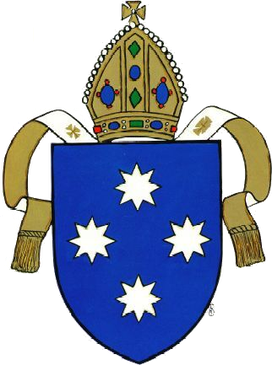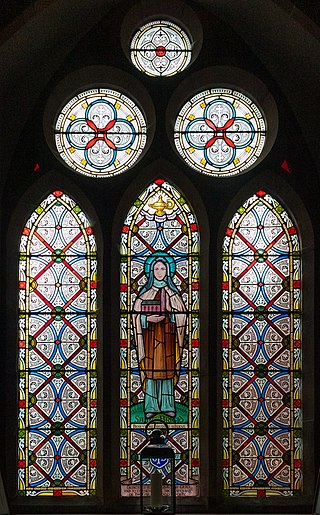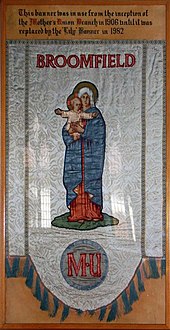
The Church of England is the established Christian church in England. It traces its history to the Christian church recorded as existing in the Roman province of Britain by the 3rd century and to the 6th-century Gregorian mission to Kent led by Augustine of Canterbury. Its adherents are called Anglicans.

The Church of England traces its history back to 597. That year, a group of missionaries sent by the pope and led by Augustine of Canterbury began the Christianisation of the Anglo-Saxons. Augustine became the first archbishop of Canterbury. Throughout the Middle Ages, the English Church was a part of the Catholic Church led by the pope in Rome. Over the years, the church won many legal privileges and amassed vast wealth and property. This was often a point of contention between Kings of England and the church.
A suffragan bishop is a type of bishop in some Christian denominations.

The Diocese of Sydney is a diocese in Sydney, within the Province of New South Wales of the Anglican Church of Australia. The majority of the diocese is evangelical and low church in tradition.
The Anglican Communion Network was a theologically conservative network of Anglican and Episcopalian dioceses and parishes in the United States that was working toward Anglican realignment and developed into the Anglican Church in North America.
The Society of the Atonement, also known as the Friars and Sisters of the Atonement or Graymoor Friars and Sisters is a Franciscan religious congregation in the Catholic Church. The friars and sisters were founded in 1898 by Paul Wattson and Lurana White as a religious community in the Episcopal Church. The religious order is dedicated to the Blessed Virgin Mary under the Marian title of Our Lady of Atonement.
The Anglican Church of Southern Africa, known until 2006 as the Church of the Province of Southern Africa, is the province of the Anglican Communion in the southern part of Africa. The church has twenty-five dioceses, of which twenty-one are located in South Africa, and one each in Eswatini, Lesotho, Namibia and Saint Helena. In South Africa, there are between 3 and 4 million Anglicans out of an estimated population of 45 million.
The Traditional Anglican Church (TAC), formerly the Traditional Anglican Communion, is an international church consisting of national provinces in the continuing Anglican movement, independent of the Anglican Communion and the Archbishop of Canterbury. The TAC upholds the theological doctrines of the Affirmation of St. Louis. Each of the respective jurisdictions utilizes a traditional Book of Common Prayer deemed to be free of theological deviation. Most parishioners of these churches would be described as being traditional Prayer Book Anglicans in their theology and liturgical practice. Some Anglo-Catholic parishes use the Anglican Missal in their liturgies. The TAC is governed by a college of bishops from across the church and headed by an elected primate.

Old Alresford is a village and civil parish in Hampshire, England. It is 1 km north of the town of New Alresford, 12 km northeast of the city of Winchester, and 14 km south-west of the town of Alton.

Mary Sumner was the founder of the Mothers' Union, a worldwide Anglican women's organisation. She is commemorated in a number of provinces of the Anglican Communion on 9 August.

The Anglican ministry is both the leadership and agency of Christian service in the Anglican Communion. Ministry commonly refers to the office of ordained clergy: the threefold order of bishops, priests and deacons. More accurately, Anglican ministry includes many laypeople who devote themselves to the ministry of the church, either individually or in lower/assisting offices such as lector, acolyte, sub-deacon, Eucharistic minister, cantor, musicians, parish secretary or assistant, warden, vestry member, etc. Ultimately, all baptized members of the church are considered to partake in the ministry of the Body of Christ.
The Anglican realignment is a movement among some Anglicans to align themselves under new or alternative oversight within or outside the Anglican Communion. This movement is primarily active in parts of the Episcopal Church in the United States and the Anglican Church of Canada. Two of the major events that contributed to the movement were the 2002 decision of the Diocese of New Westminster in Canada to authorise a rite of blessing for same-sex unions, and the nomination of two openly gay priests in 2003 to become bishops. Jeffrey John, an openly gay priest with a long-time partner, was appointed to be the next Bishop of Reading in the Church of England and the General Convention of the Episcopal Church ratified the election of Gene Robinson, an openly gay non-celibate man, as Bishop of New Hampshire. Jeffrey John ultimately declined the appointment due to pressure.

The Diocese of St Mark the Evangelist is a diocese in the Anglican Church of Southern Africa, in the geographical area of the Limpopo province in the north of South Africa.

The Federation of Anglican Churches in the Americas (FACA) is an association of six Continuing Anglican jurisdictions with nearly 600 parishes in the New World. The Federation, which was founded in 2006 to enable a closer association of these and other jurisdictions, does not include any provinces of the Anglican Communion. The vision of FACA is stated as being "faithful Anglican Churches working together in communion to fulfill the Great Commission." The Patron of FACA is Bishop Gregory Venables of the Anglican Church of South America. He is not a member of any of FACA's six constituent denominations. These denominations include the Reformed Episcopal Church, a founding jurisdiction of the Anglican Church in North America, two ministry partner bodies, the Anglican Province of America and the Diocese of the Holy Cross, and the Anglican Mission in the Americas, an initial full member but a ministry partner since December 2011.

The Episcopal Church (TEC), based in the United States with additional dioceses elsewhere, is a member church of the worldwide Anglican Communion. It is a mainline Protestant denomination and is divided into nine provinces. The presiding bishop of the Episcopal Church is Michael Bruce Curry, the first African American bishop to serve in that position.

The ordination of women in the Anglican Communion has been increasingly common in certain provinces since the 1970s. Several provinces, however, and certain dioceses within otherwise ordaining provinces, continue to ordain only men. Disputes over the ordination of women have contributed to the establishment and growth of progressive tendencies, such as the Anglican realignment and Continuing Anglican movements.
The Society of the Precious Blood is an Anglican religious order of contemplative sisters with convents in England, Lesotho and South Africa. The sisters follow the Rule of St Augustine.

The Girls' Friendly Society In England And Wales is a charitable organisation that empowers girls and young women aged 5 to 25, encouraging them to develop their full potential through programs that provide training, confidence building, and other educational opportunities. The organisation was established on 1 January 1875.
The Philadelphia Eleven are eleven women who were the first women ordained as priests in the Episcopal Church on July 29, 1974, two years before General Convention affirmed and explicitly authorized the ordination of women to the priesthood.

Rose Josephine Hudson-Wilkin, is a British Anglican prelate, who serves as Suffragan Bishop of Dover in the diocese of Canterbury - deputising for the Archbishop - since 2019: she is the first black woman to become a Church of England bishop. She was previously Chaplain to the Speaker of the House of Commons from 2010 to 2019, having trained with the Church Army before entering parish ministry.















